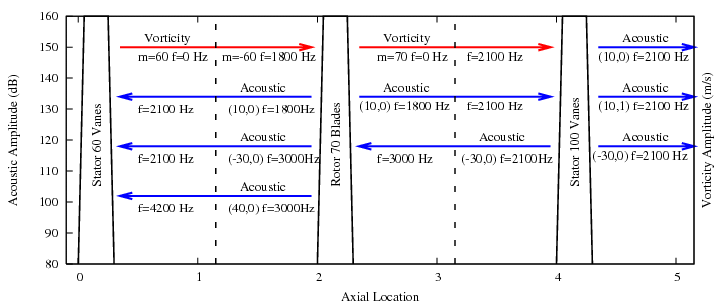Many turbomachinery applications have multiple stages.
However, for acoustic and
forced response problems, it is usual to assume that the source of unsteady flow
is just from the wake of the upstream blade-row.
Also, for flutter problems it is usual to assume that the unsteady flow is
due to the motion of an isolated blade-row.
In reality, unsteady waves are reflected from adjacent rows and also transmitted
from blade rows further up or down stream.
These reflected and transmitted unsteady waves in multi-row
turbomachinery can affect the flutter, acoustic, or forced response
behavior of a blade row.
An example of a multi-row wave plot
for a stator-rotor-stator combination is shown below.
The rotor has a frequency of 30 Hz.
Some of the possible acoustic modes generated by the
interaction of the first harmonic of the wake (vorticity waves) from the
upstream stator and rotor are shown.
It can be seen that some of the acoustic modes are reflected back to the original row
at a different frequency due to mode scattering (change in nodal diameter).

RPMTurbo can perform a multi-row unsteady wave analysis.
Linearised flow simulations are performed for each separate frequency.
The unsteady waves at the inlet and outlet are transmitted to
adjacent rows and new linearized flow simulations for adjacent rows are performed.
One important feature of RPMTurbo's multi-row analysis is the
application of an
exact 3D non-reflecting
boundary condition.
This boundary condition ensures that the correct amplitude and phase of
each mode is transmitted to the adjacent rows.
The boundary condition also prevents non-physical reflections
at the inlet and outlet which can reduce the accuracy of the linearized flow simulations.